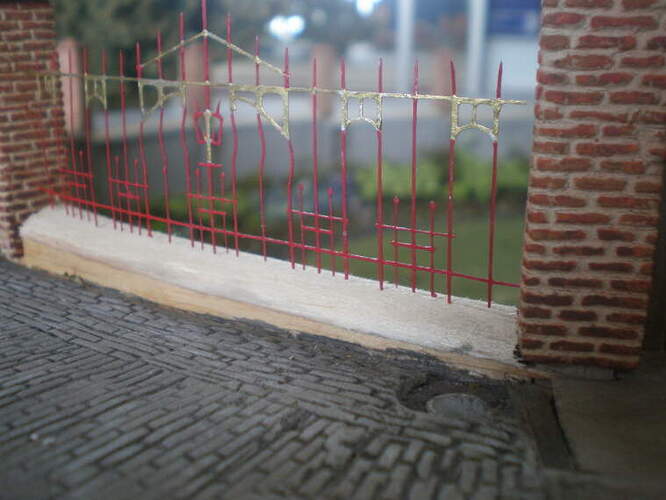Sorry for the suspense guys, I had to go dark for a while taking care of my wife 24/7 after a very bad reaction to anaesthesia for an eye operation a couple of weeks back - bad news, but the good news is she’s now got 20/20 vision in the operated eye. The other eye’s being done next week so I’ll be disappearing again, but meanwhile here’s where I’d got to with the park railings, or How I Learned To Stop Worrying and Love DIY Photo-etching.
To recap, I need 11 custom railings for this diorama and worked up the original design using MS Paint, which was then printed onto transparency stock. I’d been inspired to try out the process after discovering a short tutorial last year by David Danek on youtube, especially because he used 1/35 scale railings as the example. I followed it to the letter, but before you click on it here’s a few pointers: his accent needs some tuning into; when he says “zinc” he means of course brass; he uses wide clear tape not “duct tape”; and ignore the part from 9 minutes on where he goes on to use the quicker/stronger etching agents (hydrogen peroxide/chloride), not relevant because I used his first method. WARNING – he ain’t kidding about the safety gear, anti-fume masks & rubber gloves & goggles are essential:
So there you go, a snap right? Well here’s a bucket of ice-cold water to temper your excitement, with additional details & notes not sufficiently explained in the video:
Cost of all materials – not much change out of US $150, mostly imported to Australia so possibly cheaper for European & North American players. But I could probably make 30 or 40 more of those railings before needing to reorder anything…well, apart from more brass sheets which aren’t expensive anyway.
At 4.45 he uses the Positiv20 photo-sensitive lacquer and simply sprays it on the brass sheet holding the can nearly horizontal, seemingly in normal lighting conditions. What he didn’t mention was the following from the manufacturer’s on-line instructions, which I only searched for AFTER I’d made all my mistakes, natch:
“To overcome discontinuities while spraying, the aerosol can should not be held too tilted. After application of the film, boards must be dried immediately in the dark. The drying temperature should be increased slowly (over 15 minutes) to 70°C and kept at that temperature for approximately 15 minutes. Infrared or forced air drying is possible. When air drying at ambient temperature is used (24 hrs minimum), the quality of the film will only allow very simple work. The adhesion is poor and the danger for dust entrapment and pinholes is high.” (In fact I found letting it dry at room temp for 24 hours worked fine)
Regarding the light exposure phase, it says “In practice the exposure time is between 60 and 120 seconds when lamps are used from a distance of 25-30 cm. It is recommended to allow the lamps to warm-up for approximately 3 minutes”. I need to experiment with the exposure time some more, early results suggest at least 75 secs would produce a clearer image.
So, not quite as simple as it seems in the video.
At 5.45 the “critical phase”, chemical development. He showed us a bottle of sodium hydroxide (NaOH, aka caustic soda) at the beginning of the video without any clue to its concentration – a crucial omission, as I found out the hard way. I was only able to source pure NaOH locally in the form of a sachet in crystal pellet form, 16g. which the instructions said made 1 litre when added to water. I trawled the net looking for recommended concentration, it’s also used to develop printed circuit board (PCB) layouts. Ranging from 50g per litre (which would melt the skin right off your hands) downwards, the general consensus amongst the PCB makers was 10g worked fine & takes about 30 seconds to work. Looking again at the video, the reaction’s instantaneous so he clearly used a much stronger mix…so I figured my 16g. should be OK. Whoosh, in a micro-second I saw my railing design appear…and disappear…before my eyes before I could fish it out.
And that’s when I looked again at the tiny print on the Positiv20 can with a magnifying glass – “Use a 7g. per litre NaOH solution”, although I subsequently found that the on-line instructions specify “The exposed plate is developed by immersion in a sodium hydroxide bath (10 g/lL sodium hydroxide in water) at ambient temperature for approximately 60 seconds.” It’s a pity they can’t be consistent but whatever it’s a small variation, and clearly I had used about double the recommended concentration. So I cut the next attempt with a third of water and that dilution worked fine, taking maybe 30 or 40 seconds giving ample time to fish it out at the right time. I should add that some guys on the ‘net claim Drano or similar domestic drain-cleaners work for PCB’s, but the concentrations vary and there are usually other constituents at play, so most recommend using only pure NaOH.
Then came the etching process which is indeed as simple as represented, if scary watching metal almost visibly dissolve. So this was how one attempt looked after I’d made several errors…
…and after all that learning process this is what the latest looked like…
…and after teasing off the backing tape…
Not perfect, with some minor imperfections I can trim off later. But hey, how’s that for a novice?
Ecological footnote: the sodium hydroxide is re-usable, but eventually loses its power. Being effectively drain cleaner it can go down the sink, preferably heavily flushed down with water. Ferric chloride’s different, suffused with the metal sludge so NOT to go down any drain. I’ll dispose of it by first adding a solution containing dissolved bicarbonate of soda to neutralise it & then take it to the local waste-chemical disposal centre when I’ve done all 11 railings.
![]()
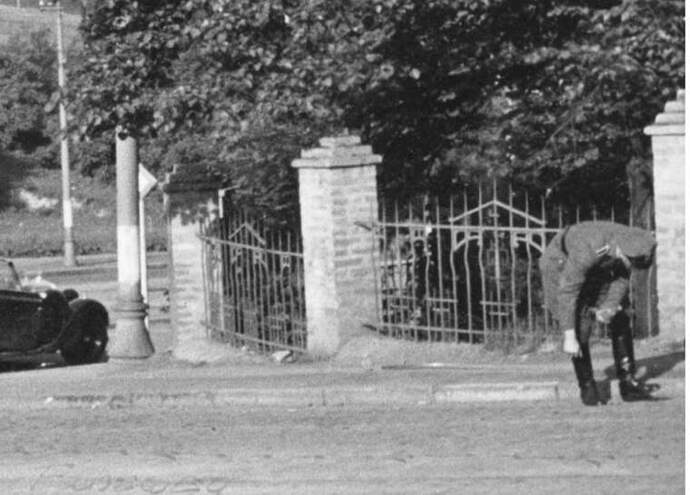


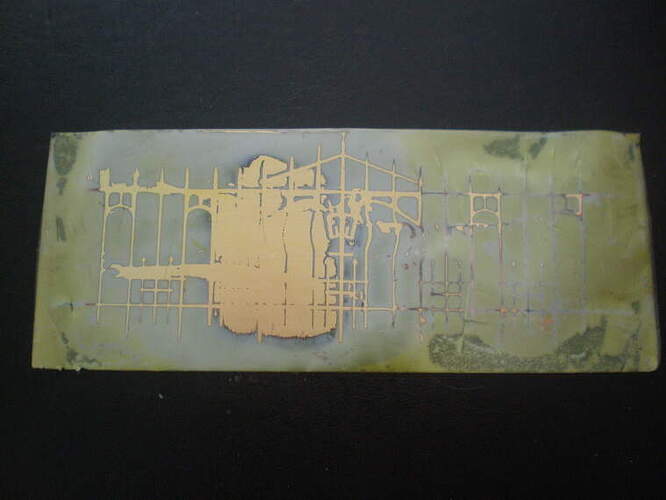
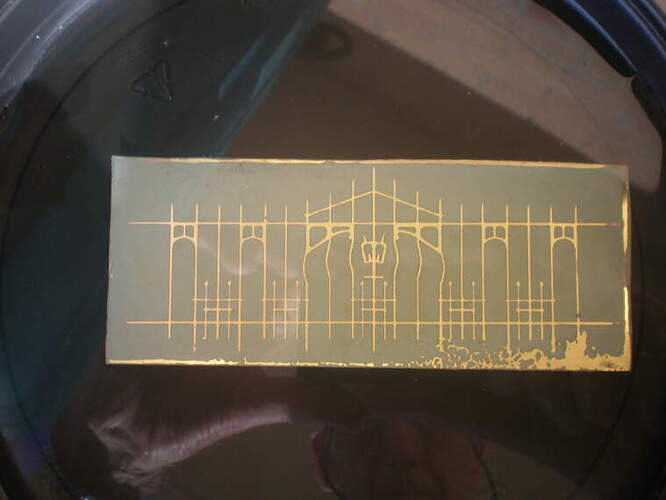
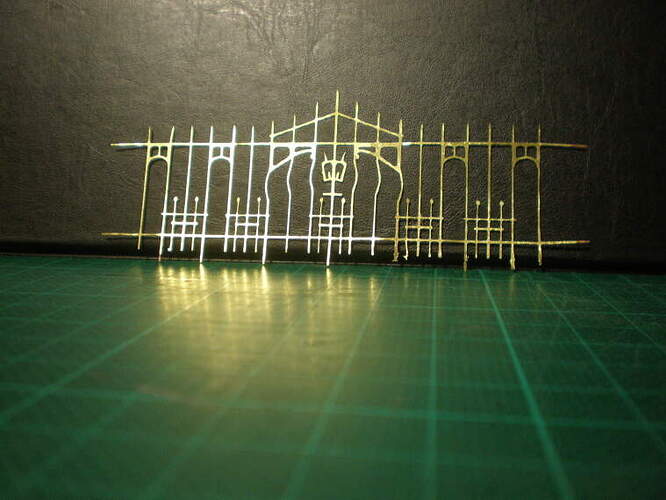
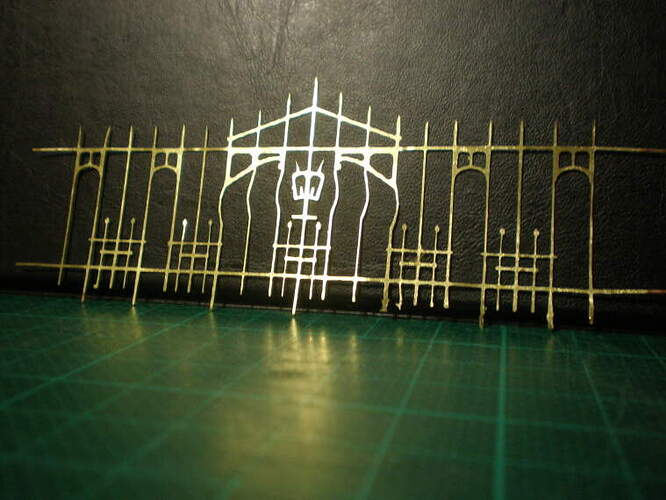
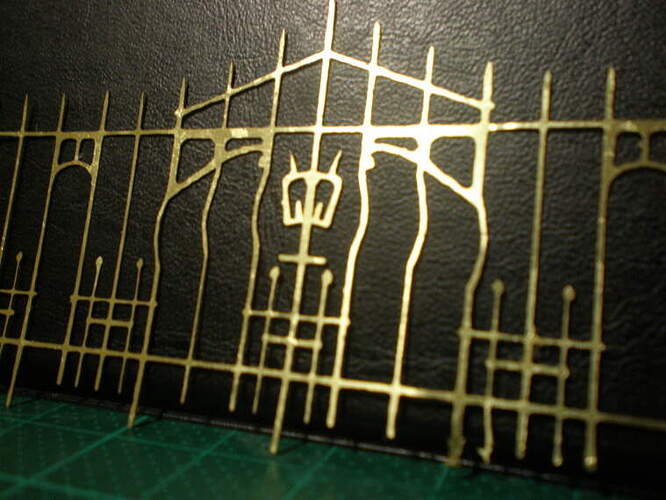
 .
. ,
,


